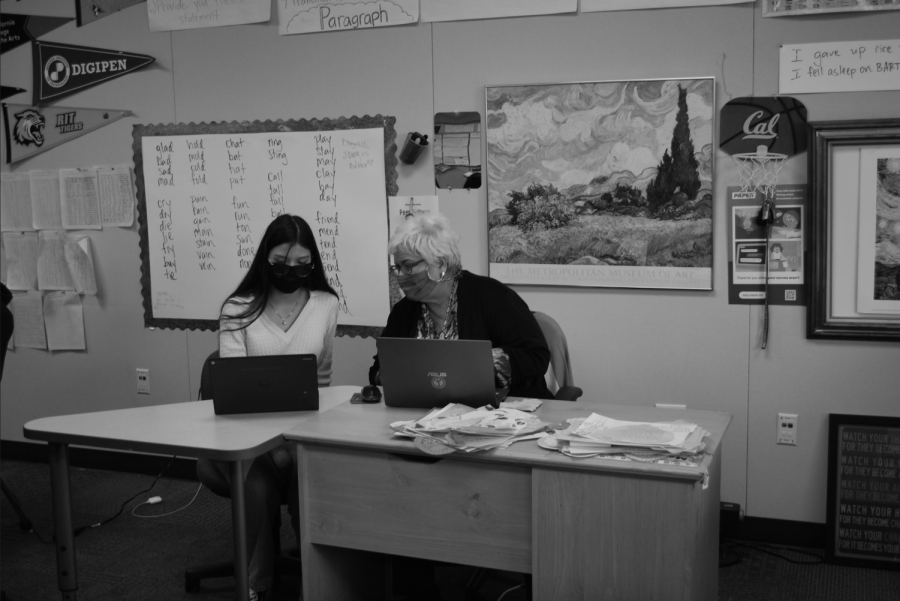CAMPUS: Co-taught classes allow students equal access to education and success in learning content
SCHS’s mission is to ensure equal access to quality education for all students. To expand support for students who struggle academically, administration introduced co-taught classes to the curriculum.
The planning process for the implementation of the co-teachings was originally introduced in 2019 through the special education department after a group of teachers visited another school to observe their co-teaching structure. The co-taught classes do not require any major funds. However, scheduling is the main obstacle.
Science teacher Suzanne Miller-Moody and special education science teacher Angelese Reed are co-teachers working with freshmen. Both have been deeply involved in the process since the beginning. Typically, students with Individual Education Plans and 504 plans are considered for placement in these classes to maintain pace with the common curriculum.
“I’ve been teaching a really long time, and one of the things that continues to be a struggle for general education teachers is, ‘How do we best address the learning capabilities of every student?’” Miller- Moody said. “It’s really, really hard to do.”
For Reed, co-teaching has enabled the general education teacher and the special education teacher to craft the lessons together in a way for students to grasp the subject matter.
“With co-teaching, it is really about the partnership between the teachers and how well they can work together,” Reed said. “If we don’t get along, then it’s going to translate to the kids, and no one is going to have a good experience.”
Freshman Christopher Perez Mendoza is enrolled in co-taught Algebra 1 and Biology. For Mendoza, the relationship between the co-teachers is crucial in order to impact students effectively.
“They should get along and they should know how to run the class together,” Mendoza said. “I think they should be able to understand the students, and it’s important that they maintain a strong relationship.”
Similarly, freshman Jenna Soper is enrolled in co-taught Algebra 1 and Biology. Soper believes the teachers are more interactive with students in the co-teaching structure due to the close relationship they share.
“In Biology, they’re honestly friends, and it’s really nice to see them get along. They’re always on the same page with each other,” Soper said. “It’s definitely beneficial having teachers that work well together. If they were constantly out of tune, that would be bad.”
New to the co-teaching model, English teacher Hanna Anderson and special education teacher Laura Adauto noticed great improvements in areas of work completion and engagement from students. They believe the format has allowed both of them to cater to various learning styles through instructional scaffolding.
“English curriculum is my expertise – I have that in my toolbelt – but Ms. Adauto knows and is familiar with the different learning styles,” Anderson said. “When we’re creating lessons together, she gives me input on how to reach certain students better based on their learning styles, so that’s always been helpful for me.”
Co-taught classes are supposed to assume an environment that replicates a mainstream classroom. While the content remains the same, the teaching approach is the key difference.
Freshman Ashton Balina is enrolled in English 9. For Balina, the co-taught classes create an efficient learning space for students while successfully fulfilling its goal.
“It feels like a normal class as any other. You just have one more teacher on top of that,” Balina said. “It’s definitely beneficial in that it’s helpful having one teacher available for help when the other is busy.”
According to Adauto, the challenge of accommodating the various learning styles has increased with larger class sizes since the co-taught classes were designed to interact and address the needs of a smaller student population.
“It’s a double-edged sword because when Ms. Anderson says there’s extra eyes (more teachers) in the classroom, the tendency is to want to put more students in our class than we can accommodate for and deal with their specific learning styles,” Adauto said.
Anderson and Adauto also provide the option of distance learning for students who need to quarantine due to COVID-19, which Anderson believes can still be detrimental to their progress.
“What happens is they fall behind and they continue falling behind because if they’re gone for 10 days in order to quarantine, then they miss out on half of a unit,” Anderson said. “Co-teaching can’t save that.”
According to Adauto, the co-taught classes cannot function to their maximum potential without a strong bond. To emphasize this point, Adauto compared it to dancing.
“We always consider it more like a dancing class. She might know how to do hip-hop, and I don’t know how to do that. But we kind of learned how to figure out what steps I can do to connect with her,” Adauto said. “We dance and we have fun.”


